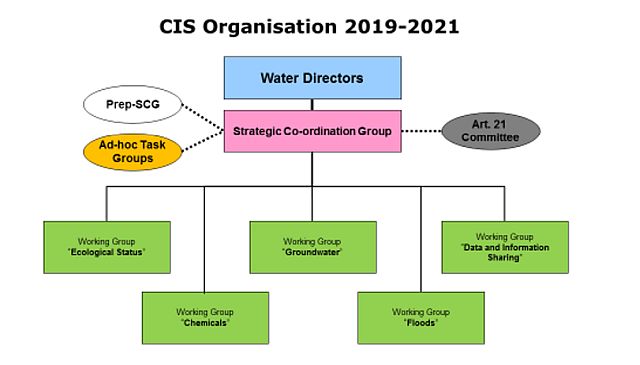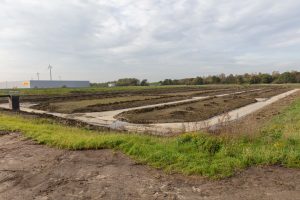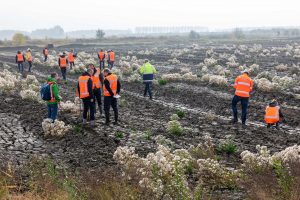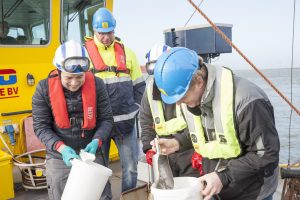Website: www.SedNet.org
Compiled by: Marjan Euser (marjan.euser@deltares.nl)
Subscription Service: SedNet Secretariat (marjan.euser@deltares.nl)
Disclaimer: SedNet is not responsible for faults due to incorrectness of info in this newsletter
Previous issues: www.sednet.org/newsletter
Contents:
- Sediment flagged up in Water Fitness Check
- SedNet member WFD & FD strategic coordination group
- Guidance document on sediment management in support of the WFD
- Start of SedNet Working Group “Education-Science-Policy Interfacing & Sediment Management Concepts” (WG ESPI-SMC)
- Workshop of the SedNet Working Group on Sediment Quality
- Update from SedNet Working Group Circular Economy
- SURICATES pilot Port of Rotterdam
- 12th International SedNet Conference, Lille, France
- Emerging environmental issues related to climate change
- Seeking a solution inside a problem: “Contaminated-sediments as a source of Hg-detoxifying marine bacteria for bioremediation”
- Sediment Classification and Management Decisions – in situ and ex situ
- Sullied Sediments project about to conclude
- Upcoming events
Click here for the pdf version of the newsletter.
Sediment flagged up in Water Fitness Check
The Water Fitness Check has been published Thursday 12 December 2019. This fitness check is a comprehensive policy evaluation of four Directives on integrated water management: WFD, EQS, GD and FD. It assesses whether the Directives are fit for purpose. It flagged up chemicals as key area where there is room to improve and to achieve better results. At several places it mentions the binding to, and accumulation and monitoring of chemicals (pollutants) in sediments.
However, the fitness check also flags up several other sediment and water related issues:
“Hydromorphology is a term used to describe the hydrological and geomorphological characteristics (including continuity) of rivers, lakes, and coastal and transitional waters, including the underlying processes from which they result. Water and sediments interact at different scales and shape the physical environment, determining physico-chemical processes and providing a physical habitat for the biota. Hydromorphological alterations are associated with water storage, irrigation, flood protection, navigation, urban development and changes in land use. Hydromorphological pressures reported by Member States include physical alterations (26%), dams, barriers and locks (24%), hydrological alterations (7%) or other hydromorphological alterations (7%)” (page 21 of the fitness check)
And:
“A further area is sediments. Sediments are transported from river basins to marine areas, but in many river basins there are insufficient or no management measures for sediments at river basin level. This can be an issue for marine habitats when the supply of sediment is insufficient to prevent or compensate for coastal erosion. The MSFD status assessment places specific emphasis on contaminants in sediments. In contrast, the WFD, while allowing Member States to set EQSs for sediments, addresses such contamination primarily in the context of the trend-monitoring requirement under the EQSD. Some stakeholders, in particular from the navigation sector, expressed concern that the interplay between the WFD and MSFD does not function well enough on sediment management.” (page 86 of the fitness check)
And:
“To achieve the WFD’s objectives, Member States need to draw up and implement the necessary measures. Among these are demand management and coordination with other plans and programmes, including land management and soil protection action aimed at reducing the risk of desertification. For more on this issue, see the European Court of Auditors’ report on desertification. Measures to reduce sediment from soil erosion and surface run-off are also included in the second RBMPs and have been reported for 34 RBDs.” (page 171 of the fitness check)
And:
“Navigation activities can also affect chemical status, as ships, boats and the infrastructure to support them can cause a range of environmental problems. In particular, they can lead to direct emissions of contaminants by boats, but also to indirect contamination by remobilisation of contaminated sediments. The use of anti-fouling products has in particular led to contamination of water. Due to aquatic toxicity and persistence, the use of organotin compounds in anti-fouling coatings has been banned since 2008.” (page 173 of the fitness check)
And:
“Extractive activities are placed where the natural resources exist, with no or very limited possibilities to be relocated. In some cases, they involve high concentrations of certain elements due to natural background levels and/or diffuse pollution. If suitable measures are not implemented, mining activities can affect freshwater ecosystems in different ways through changes in the groundwater and surface water hydrology, or through the release of chemicals and/or sediments in water. Impacts on water will depend on the type of mineral, mining practices, substances used at the processing stage, and the way mining waste is handled. If not properly addressed, these impacts can occur during the exploitation of the mine, but also long after the cessation of activity.” (page 175 of the fitness check)
See further at:
– Press release
– Water Fitness Check (SWD)
– Water Fitness Check web page
SedNet member WFD & FD strategic coordination group
On 18 September 2019 the European Sediment Network SedNet became as NGO official member of the Strategic Coordination Group (SCG, see figure) of the Common Implementation Strategy (CIS) of the Water Framework Directive (WFD) and Floods Directive (FD).
Through its SCG membership SedNet gets optimal opportunities to continue to raise attention for sediment management and bring in sediment management expertise and experience in support of European water policy implementation. This is needed as SedNet stated in its 2017 policy brief that European water policy objectives will only be achieved by also integrating sediment in River Basin Management Planning.
The role of the SCG is the co-ordination of the different working groups and activities under the common strategy such as the work in the pilot river basins. The strategic co-ordination group will evaluate the outcome of the different working groups and prepare documents and reports for the Water Directors’ meetings and give guidance to the key activities. The main objectives of the CIS are to ensure a better implementation of the water legislation and to promote the integration of water related issues in other environmental policies, as well as in other sectoral policies such as agriculture, transport or energy (Rules of procedure for the SCG under the WFD and FD CIS, June 2019).
Guidance document on sediment management in support of the WFD
The CIS work program for ECOSTAT for 2019-2021 includes the topic “sediment”, with the main aim to exchange information and best practice between Member States and stakeholders. A workshop was organised by ECOSTAT and SedNet in April 2019 in Dubrovnik, which led to the conclusion that there was a need to draft a CIS guidance document on sediment management in the context of the WFD, in order to share good practices, common languages and provide common interpretation on the role of sediment management in the context of the WFD.
A core-group was nominated to coordinate this work. The work will be divided into 4 sub-groups to draft each chapter of the document. The document will be divided in 4 chapters – Catchment Scale Analysis; Sediment Quantity; Sediment Contamination; Integrated Sediment Management Planning. For each chapter, a group of experts will be established to draft and review the content. Each chapter is expected to be around 20 pages and to focus on key messages, with reference to other documents/reports for more precise information. In addition to the main text of the guidance, a library of existing information (publications, reports, guidance, management plans, case studies, …) will be set up and maintained.
SedNet steer group members participate in the core-group as well as the sub-groups. For more information please contact Jos Brils, the SedNet delegated member to the WFD CIS SCG and ECOSTAT sediment core-group.
Start of SedNet Working Group “Education-Science-Policy Interfacing & Sediment Management Concepts” (WG ESPI-SMC)
Since a long time SedNet wishes to compile all relevant experience in sediment management in a guidance document. Also SedNet would like to communicate with and educate students and other interested people about sediment management. In this way our work will be better understood and appreciated.
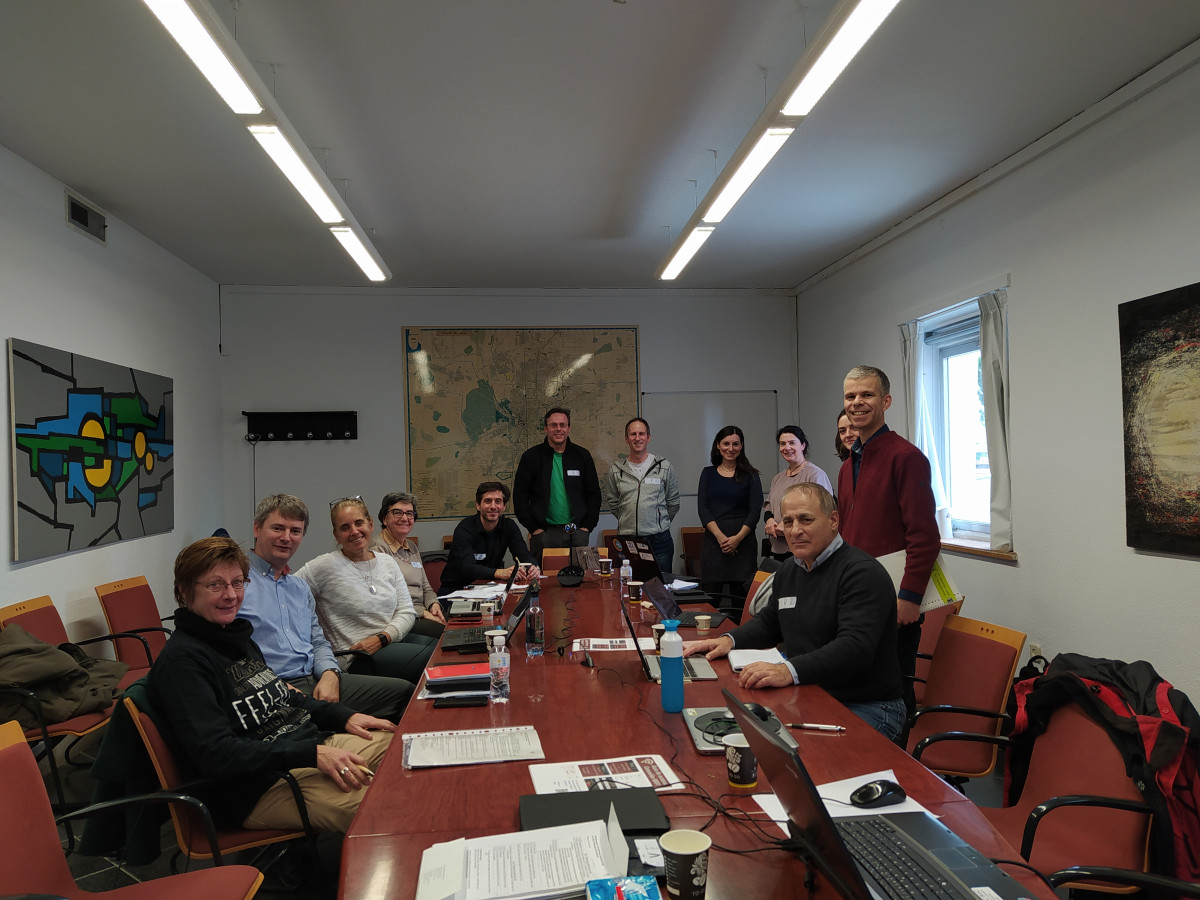 To achieve this SedNet organized the first workshop/meeting of the SedNet Working Group “Education-Science-Policy Interfacing & Sediment Management Concepts” (WG ESPI-SMC) on Wednesday 20th and Thursday 21st of November 2019 in Madrid. During the workshop experiences of setting up sediment management concepts of the Rhine, Elbe and Scheldt were exchanged. Also the lessons learned of making a sediment guidance document made in the USA in 2005 were presented. A rough plan of action to write out a SedNet guidance document about how to set up sediment management concepts was made. This guidance document will be developed by the WG ESPI-SMC in 2020-2021 and will be supplementary to the guidance document that the European Commission (ECOSTAT) is developing in the same period.
To achieve this SedNet organized the first workshop/meeting of the SedNet Working Group “Education-Science-Policy Interfacing & Sediment Management Concepts” (WG ESPI-SMC) on Wednesday 20th and Thursday 21st of November 2019 in Madrid. During the workshop experiences of setting up sediment management concepts of the Rhine, Elbe and Scheldt were exchanged. Also the lessons learned of making a sediment guidance document made in the USA in 2005 were presented. A rough plan of action to write out a SedNet guidance document about how to set up sediment management concepts was made. This guidance document will be developed by the WG ESPI-SMC in 2020-2021 and will be supplementary to the guidance document that the European Commission (ECOSTAT) is developing in the same period.
Also first ideas were gathered to create a “Sediment (serious) game”. A draft of this game will be developed and tested in 2020 by the WG ESPI-SMC. We hope to “play” the game on the next SedNet conference in 2021. If successful, it would be nice to create after that a professional online version of the game in different languages to teach secondary school students and university students the principals of good sediment management. Next to that the WG ESPI-SMC hopes to create an educational learning package. But the WG ESPI-SMC also wants to create communication tools like movies about good sediment management practices.
Want to follow the work of the WG ESPI-SMC? Want to help by mail or at one of the next workshops? Please, let us know. Contact: SedNet secretary Marjan Euser!
Workshop of the SedNet Working Group on Sediment Quality
elucidating The Role of Ecotoxicological Data in Sediment Quality and Dredged Material Assessment Frameworks
We would like to invite interested experts from academia, industry/business and government to join us in Rome on 10-11 March 2020, to discuss experiences, challenges and approaches regarding the use of biotesting and ecotoxicological data in the assessment of sediment and dredged material quality. In addition to the concentration of hazardous substances in sediments, their effects on the biological community is gaining attention in quality assessment. Effects can be addressed e.g. by direct biotesting of sediments and/or the use of ecotoxicologically based sediment quality criteria. Among a variety of different approaches and related issues that come with their application in Europe, we will focus on 4 topics in this workshop. We would like to
- review on how ecotoxicological testing is applied in sediment quality and dredged material assessment frameworks in different countries. Please share your experiences and problems with us. Let us discuss opportunities and challenges and whether there is a way – or indeed a need – for international harmonization of biotesting sediments.
- reflect on sediment quality criteria and their efficiency to protect the environment and its living resources. We would especially like to look at the OSPAR EACs (Environmental Assessment Criteria) and threshold levels applied in the Mediterranean Sea in the context of risks from hazardous substances in the marine environment.
- discuss possibilities and methods to back calculate EQSs for the WFD to produce sediment quality guidelines
- shed a light on the applicability of passive sampling methodology to derive thresholds suitable for assessment purposes.
The workshop will be free of charge and will last from midday on March 10 to the evening of March 11.
The number of participants will be restricted to 25 people. If you are interested, please contact Susanne Heise.
Update from SedNet Working Group Circular Economy
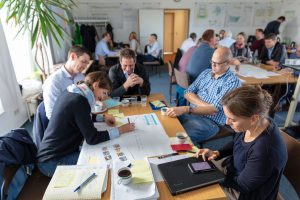 Twenty-five participants representing nine countries met in Bremen (DE) and Delfzijl (NL) last October to exchange on Circular Economy practice and opportunities, and visit operational sites.
Twenty-five participants representing nine countries met in Bremen (DE) and Delfzijl (NL) last October to exchange on Circular Economy practice and opportunities, and visit operational sites.
A presentation on the port of Bremen dredged material management site allowed to discover low energy treatment in dewatering basins and on-site disposal, and the role of nature in processes when land is available. A visit to the Ecoshape pilot site in Delfzijl allowed to complement the observations and to discuss site instrumentation for monitoring, desalination issues and agricultural beneficial use opportunities.
Small group sessions were led on priority topics identified during the spring meeting of the WG:
- Clear definitions of concepts (beneficial use, valorisation, reuse, sustainability)
- Beyond the initial “mass balance” approach to CE, need for defining ‘value’ to ecological potential of sediment
- Incorporating CO2 and CH4 balance of sediment use in CE balance and funding, benefit or risk?
- Setting up a synthetic catalogue of beneficial use options.
A WG white paper can be initiated with the outcome.
The focus of the WG-meeting was on a System-analysis workshop. This system thinking method allows investigating overlooked or long term options, to the opposite of Business as usual strategies. Group work between participants was productive – and fun!
Future meetings will include both field visits (pilots, plants and workshops) and elaborating project proposals and policy/RTD support documents.
The fourth meeting of the SedNet Working Group on Circular Economy (WGCE4) might be set up in March or April 2020, possibly including invited talks by speakers on beneficial use experience in the US, and on binders for facilitating beneficiary use of sediments.
SURICATES pilot Port of Rotterdam
During the 3th meeting of the SedNet Working Group on sediment use in circular economy in Bremen/Delfzijl on 23 and 24 October 2019 the Dutch SURICATES pilot in the port of Rotterdam was presented. SURICATES is an EU INTERREG IV program on Sediment Uses as Resources In Circular And Territorial Economics. One of the pilot locations is Port of Rotterdam, where 200.000 tons of sediment (estimated dredged volume of 500.000 m3) is reallocated within the harbour. The purpose of the reallocation is to shorten the trip (alternative is reallocation at sea) and at the same time enhance the sedimentation at the river banks to stimulate nature development and enhance erosion protection. To avoid siltation and navigation problems in the harbour the reallocation is done shortly after dead tide, with an ebb flow to carry most of the sediments towards the sea (where is enhances the sediment balance for the beaches). To study the sediment behaviour new measuring techniques are being deployed:
- Use of optical cables to measure the sediment transport at the reallocation site by measuring the sediment coverage on two ~1 km long cables
- Use of rare earth elements in sediment to characterise the origin of the sediment, hence fingerprinting the distribution of the reallocated sediment as compared to the original sediments
- Use of ADCP backscatter data to measure the transport and settling of the dredging flume after reallocation
- Laboratory tests on the rheology in relation to the change in sediment properties when reallocated from a more fresh water into a more marine environment
The first results are that the sediment does not accumulate in the main shipping channel, also not in the reallocation area. The fingerprinting with rare earth elements demonstrate that indeed part of the sediment are settling on the banks. but the main target area (a constructed wetland) is not receiving enough sediment due to the position of the wetland in the inner curve of the channel while most sediments are transported in the outside curve of the river. This are first results. Most raw data is collected over the summer of 2019, when the reallocation took place. Processing of the data and lab tests will continue in 2020.
For more info about SURICATES click here.
12th International SedNet Conference, Lille, France
The next SedNet conference will take place in Lille, early in 2021. Both the exact date and location are still to be decided, but we expect it will be a great event, following the successful Dubrovnik conference.
Lille is the capital city of Northern France, an historic and vibrant place with lots of research and education institutes. It is part of the NL-BE-FR EuroRegion, accessible by fast connexions from UK and Germany too.
Lille is a fantastic place for sediment topics, being surrounded by major ports (Boulogne, Calais, Dunkirk, Zeebrugge, Oostende, Antwerp, Gent, with Rotterdam not that far) and by a dense transboundary network of large waterways. We hope to be able to offer not only one, but at least two excursions during the conference.
The conference theme shall be: “Sediment Challenges and Opportunities with Climate Change, and Sustainable Development Goals”. It will allow a broad coverage of environmental topics, as well as circular economy issues. A provisional list of topics and sessions is as below:
- Climate change and sediments: direct and indirect consequences and opportunities. Sediments in a changing Environment
- How can sediment management influence ecosystem services provision?
- Circular economy – sediment as a resource. Remediation and uses / Building with Dredged Materials and/or Sediments
- Sediment management concept and sediment policy. Policy for sediment management / transboundary sediments & innovative maintenance of river delta sea systems
- Sediment quality guidance, sediment quality assessment. Assessment and analytical methods, quality guidance
- How to deal with emerging substances / PFAS / microplastics
- Impacts of disturbed sediment continua and mitigation measures? Sediment balance / Understanding sediment fluxes and budgets on a river basin scale/ HORIZON Europe, Land use impact of sustainable sediment management
- Sediments in the coastal-marine zone management and EU strategies (HORIZON Europe, Blue Growth, etc.)
Possible other topics include:
- Sustainable food production and/or consumption solutions and their effect on sediments and climate change (and vice versa)
- Sediments in historical and recent mining areas – effects of remedial measures
A call for abstracts will be issued early in 2020 – prepare your abstracts, and stay tuned!
We look forward to seeing you in Lille and to having a great time together.
Emerging environmental issues related to climate change
In collaboration with the journal Frontiers in Environmental Science, section Toxicology, Pollution and the Environment an article collection is being organized on “Emerging Issues Regarding the Intersection of Climate, Toxic Substances, and Environmental Health” (Guest Editors: Raul Perez Lejano, Kyung-Min Nam, Susanne Heise, Peter S Hooda). The aim of this project is to bring together international experts to provide a comprehensive view of this topic. Would you like to participate as a contributing author?
The full description of this project can be found here. The submission deadline is Jun 30, 2020.
Seeking a solution inside a problem: “Contaminated-sediments as a source of Hg-detoxifying marine bacteria for bioremediation”
The MER-CLUB Project “MERcury Clean-UP system based on Bioremediation by marine bacteria” has been recently funded by the European Commission Blue Economy EASME Call in the topic Blue Labs – Innovative solutions for maritime challenges.
Mercury (Hg) pollution is a critical problem worldwide with large socio-economic, environmental and health impacts. Industrial pollution, particularly from chloralkali plants, is destructive to the marine environment at local, regional and global scales, raising serious concerns for ecosystems and human health. International initiatives, such as the Minamata Convention, are seeking to reduce Hg in the environment, forcing engaged parties to reduce emissions and remediate contaminated sites. In line with the latest objective, MER-CLUB aims at delivering a Hg clean-up system based on marine bacteria that can be used for bioremediation of marine sediments.
Marine microorganisms hold the genetic potential for Hg detoxification and may represent an economical and highly efficient alternative for decontamination. Using recent advances in environmental genomics, cell sorting and Hg stable isotope tracing, MER-CLUB aims at identifying strains and consortia with potential for Hg bioremediation in marine sediments from the Baltic, Mediterranean and the Atlantic. Therefore, MER-CLUB will target the largely unexplored diversity of marine Hg detoxifiers and the isolation and functional characterization of novel detoxifying marine strains or consortia, with the ultimate aim of designing a clean-up system based on immobilized bacteria able to operate in dredged marine sediments.
This new European project, coordinated by AZTI and ongoing since 1st November 2019, will be developed by a consortium of high-level international research groups specialized in marine microbiology, metagenomics, environmental assessment, and mercury biogeochemistry from Spain (AZTI, CSIC, UAB), Sweden (SLU), France (UPPA) and Germany (GMBU). The project also includes the participation of a SME (AFESA Medio Ambiente S.A.) which is currently involved in the decontamination of several chlor-alkali plants.
The project has been launched in the EASME kick-off meeting (Brussels, 5 December 2019) by the coordinator team from AZTI.
If you want to know more about MER-CLUB, please do not hesitate to email the project coordinator Dr. Laura Alonso-Sáez or follow the MER-CLUB updates at www.mer-club.eu and social media.
Sediment Classification and Management Decisions – in situ and ex situ
In 2003, den Besten et al.[1] provided an overview over different biological effect-based sediment quality assessments in Europe and concluded that there was a considerable difference between European countries in the way sediment quality guidelines (SQGs) were derived and implemented. Furthermore, the extent to which biological data were integrated in frameworks varied a lot and ranged with regard to dredged material assessment from “none” to “part of a decision support system”. Between 2003 and today, national frameworks will have changed due to new information on SQGs, new analyses methods, or due to different political incentives. In order to discuss the different current national approaches and trends on sediment and dredged material assessment in regulatory frameworks, a workshop was initiated by the Workgroup Sediment Quality of SedNet in cooperation with the project Sullied Sediments. The report has now been published and can be downloaded via this link.
[1] den Besten PJ, de Deckere E, Babut MP, Power B, DelValls TA, Zago C, et al. Biological effects-based sediment quality in ecological risk assessment for European waters. Journal of Soils and Sediments. 2003;3(3):144 ff.
Sullied Sediments project about to conclude
The Interreg-project Sullied Sediments (2017-2020) has finished its sampling period and now heads towards its conclusion phase. At 3 watershed, 7 sampling surveys were performed of the course of 2 years at the same time: Elbe and Humber catchment and Scheldt river basin district. Three sampling sites at each watershed had been chosen with respect to the potential impact of waste water treatment plants, due to the special focus of the project on Watch List chemicals. These are currently not regulated under the European Water Framework Directive but introduced into our waterways as a result of our day-to-day activities and through industry. Regardless of the source, they accumulate in the sediments in our rivers and canals.
Sullied Sediments gathered data on old and new sediment contaminants in sediments, their ecotoxicological effect and on the health of the biological community at the respective sites. These data in combination with new analytical methods and assessment tools will be used to inform water sector partners across the North Sea Region and enable them to make better decisions with regard to the management, removal and disposal of sediments, thereby reducing economic costs to private and public sector organisations, and the impact of these pollutants on the environment.
The expert system for making decisions on contaminated sediments and dredged material will be presented to interesting parties next spring via a webinar. Please watch out for announcements on the Sullied Sediments Website or the SedNet website. For further information on the project, please contact Annabel Hanson or the project lead Jeanette Rotchell. For information on the expert system for decision making, contact Susanne Heise.
Upcoming events
10-11 March 2020: workshop SedNet Working Group Sediment Quality elucidating the role of ecotoxicological data in sediment quality and dredged material assessment frameworks.
Workshop venue: Ispra, Rome, Italy. (See article in this newsletter)
14-18 June 2020: ContaSed2020, University of Bern, Switzerland.
2nd International Conference on Contaminated Sediments. ContaSed2020 will focus on organic and inorganic sediment contaminant classes including microplastics, emerging contaminants, heavy metals and persistent organic pollutants.
Deadline for abstract submission is 15 January 2020.
More info at the conference website.
25-26 June 2020: RIVER BASINS 2020 Conference, at the Budapest University of Technology and Economics, Hungary.
Conference theme: Solids in River Basins – Solids and particle bound pollutants, with focus on Modelling, Monitoring and Management.
Deadline for abstract submission is 20 January 2020
More info at the conference website.
7-10 July 2020: RIVER FLOW 2020, Delft, The Netherlands.
10th Conference on Fluvial Hydraulics under the auspices of IAHR, with masterclasses on the 6th of July.
The conference themes include: sediment transport, sediment mining, climate adaptation, morphodynamics, ecosystem services etc.
Find updates or subscribe to the newsletter at http://www.riverflow2020.nl.
7-10 July 2020: 7th International Symposium on Sediment Management (I2SM), Lille, France.
The symposium is organised by IMT Lille Douai.
The deadline for abstract submission is 20 December 2019. The template for abstracts is available from rachid.zentar@imt-lille-douai.fr and i2sm2020lille@imt-lille-douai.fr.
Selected papers will be published in international peer reviewed journals. Poster presentations are also encouraged, since papers accompanying a poster will be equally considered for publication.
Spring 2021: 12th International SedNet Conference, Lille, France
“Sediment Challenges and Opportunities with Climate Change, and Sustainable Development Goals”
Conference date and Call for abstracts will be announced in spring 2020.
Disseminated by:
SedNet secretariat:
Mrs. Marjan Euser
Deltares
P.O. Box 85467
NL-3508 AL Utrecht
The Netherlands
Email marjan.euser@deltares.nl

